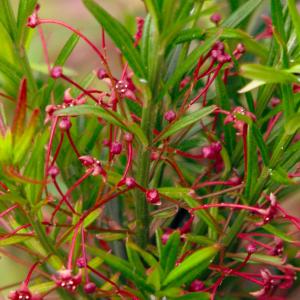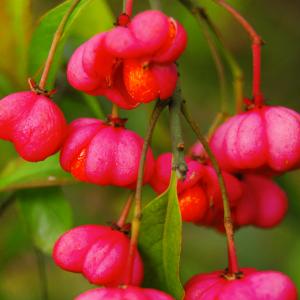文章
Miss Chen
2017年07月19日


Nombre científico o latino: Buxus sempervirens
Nombre común o vulgar: Boj, Boj común, Boje.
Familia: Buxaceae.
Origen: originario de Europa, norte de África y oeste de Asia.
El boj se halla distribuido en colinas secas y rocosas y en zonas de matorral del SO y CO de Europa. En España principalmente en el cuadrante noreste. Abundante en algunos puntos de Europa y Norte de Africa.
Arbusto perennifolio y monoico de larga vida.
Altura y diámetro del boj: 1 m x 1,5 m. No sobrepasa los 5 m de altura.
Crecimiento muy lento, incluso unos pocos centímetros en todo un año.
El boj es un arbusto de hojas enteras, opuestas y coriáceas.
Posee numerosas ramas rígidas de corteza pardo-clara, por lo general agrietada profundamente.
Hojas opuestas y coriáceas de 1,5-3 cm, de color verde oscuro lustroso por la haz y más pálidas por el envés, con los bordes ligeramente enrollados.
Flores pequeñas, blanquecinas, de olor desagradable, dispuestas en inflorescencias axilares de 5 mm de diámetro.
Flores sin pétalos, en inflorescencias axilares de varias flores masculinas y una femenina.
Fruto coriáceo en principio verde y luego pardusco, del tamaño de un garbanzo, con tres cuernecitos y semillas de un negro lustroso.
El fruto del boj se presenta en cápsula, con dos semillas en cada cavidad. Cada glomérulo presenta una flor femenina en el ápice y varias masculinas debajo de ellas.
La madera de boj se utiliza para el grabado, la escultura y la taracea, ya que es muy dura y homogénea y tiene un color amarillo limón.
Madera densa, no flota en el agua.
Atención: las hojas y semillas del boj son venenosas.
Propiedades homeopáticas, se usa contra el reumatismo.
Existen numerosos cultivares de boj: 'Elegantissima', 'Faulkner', 'Handworthii', 'Latifolia maculata', 'Nana Hort', 'Rotondifolia', etc.
El boj es una buena planta de hoja perenne para macetas.
En jardineria es apreciado el boj porque se pueden formar setos y molduras de bajas necesidades de corte (crece lentamente).
Las ramillas del boj también se usan para la confección de ramos de flores, centros de mesa, etc.
Se utiliza con frecuencia en jardinería para la formación de setos de boj porque soporta bien las podas y no pierde el follaje en invierno.
En invierno prefiere una temperatura fresca, de 3 a 10º C.
En primavera y en verano, es preciso sacarla al aire libre a la planta de boj.
El boj prefiere exposiciones a semisombra, aunque tolera las de pleno sol; siempre y cuando se riegue de forma que el suelo se quede siempre ligeramente húmedo.
Se adapta a todos los suelos, aunque prefiere los de ph neutro y algo calizos.
Ofrece buena resistencia al frío, al viento y a la sequía.
Riego del boj: en verano, conviene dejar secar ligeramente la tierra antes de volver a regar, evitando siempre los encharcamientos. En invierno hay que regar con prudencia.
Aplicar abono para plantas verdes.
El boj es proclive a padecer enfermedades por hongos.
Hay una plaga en el boj que se come las hojas.

Multiplicación del Boj:
Generalmente se usan estacas.
Rara vez se usan semillas, debido a que las plántulas se desarrollan con lentitud.
Las estacas pueden ser de madera suave tomadas en el verano, o de madera semidura tomadas en el otoño.
Las del otoño se enraizan en un invernadero frío o cama fría durante el invierno y la primavera o bajo niebla en cualquier época del año.
Las estacas enraizadas estarán listas para sacarse al fin del verano.
Plagas y enfermedades del Boj:
ENFERMEDADES DEL BOJ
Chancro.
Suele darse en plantas viejas y en ramas lesionadas o rotas. Es la enfermedad más grave del Boj. Disminuye el crecimiento y el vigor de la planta.
Las hojas toman un color amarillento o atabacado y quedan pegadas a las ramas.
Hojas y ramas atacadas presentan pequeñas pústulas de color rosado, que son las fructificaciones del hongo Pseudometria rousseliana.
En los chancros se forman en primavera pústulas de color rojo vivo.
Podar y quemar las ramas muertas del boj. Los chancros se cortan por debajo de ellos.
Preventivamente, durante el invierno se pueden aplicar pulverizaciones con caldos de cobre. Recoger y quemar las hojas caídas.
Moteado de las hojas y socarrina.
Hongo Mycosphaerella patouillardi. Las hojas presentan en los bordes manchas blancas, sobre las que se observan puntitos negros y se secan y caen esa zona, quedando las hojas como mordidas por el borde.
Otro hongo que forma manchas redondeadas amarillo pajizo o marrón con puntitos negros es Ascochyta o Phyllosticta buxina.
Las hojas atacadas del boj acaban por secarse y caer. Están indicados los tratamientos con fungicidas en primavera y principios de verano. Es conveniente también sacudir las ramas del seto para hacer caer las hojas secas y quemarlas.
Roya.
En las hojas se ven abundantes puntos (llamadas pústulas) negros. Es el hongo Puccinia buxi, cuya propagación puede contenerse con pulverizaciones repetidas de azufre, maneb, mancozeb, zineb, etc.
Defoliación o muerte por sequía o helada. La brotación es pobre, las hojas se secan y caen y mueren ramas.
Esto puede ser por sequía, fuertes calores y por falta de riego. También por heladas invernales o primaverales.
Podredumbre de la raíz.
Las hojas se decoloran y la planta se marchita y muere. Son los síntomas que provoca el hongo Phytophthora cinnamomi. Las plantas de boj atacadas se deben arrancar.
PLAGAS DEL BOJ
Mosquito del boj.
Las hojas se ven con galerías que hacen unas larvitas de 3 milímetros de largo.
También pequeñas ampollas. En abril se ven volar nubes de mosquitos (Monarthropalpus buxi). La hembra taladra la epidermis de las hojas y pone los huevos.
Sólo tienen una generación en el año, pero causan bastante daño.
Puede combatirse mediante pulverizaciones repetidas en primavera, desde los primeros días de abril con Maltion.
Cortar ramas muy afectadas del boj.
Contra las larvas jóvenes, puede provarse en abril o mayo un insecticida penetrante como Diazinon.
Cochinillas.
Aspidiotus hederae, Piojo rojo de los Cítricos, Parlatoria, Pinnaspis buxi, etc.
Todas ellas pueden combatirse pulverizando los setos en primavera y verano.
Meleta.
Las hojas de los extremos terminales del boj se ven deformadas y, tanto las ramillas como las hojas, quedan más o menos recubiertas de una melaza excretada por unos pequeños insectos chupadores (Psylla buxi) que están recubiertos por una materia algodonosa blanca.
El adulto mide 2 milímetro y parece un mosquito. Las larvas avivan en primavera y chupan los jugos de las hojas, protegidas por esa sustancia cerosa blanca.
Se combaten como las Cochinillas.
Nematodos.
Las raíces del Boj son atacadas por pequeños gusanos nematodos del género Pratylenchus, que debilita la planta.
Arañuela.
Hojas amarillentas o parduzcas, con un tono plateado debido al ataque de un pequeño ácaro (Eurytetranichus buxi).
Los huevos avivan en primavera y las larvas chupan la savia de las hojas nuevas, pudiendo causar en verano importantes daños.
Las pulverizaciones contra Cochinillas mata a muchos Ácaros invernantes en el boj. En primavera hay que usar acaricidas.
0
0
文章
Miss Chen
2017年07月17日


Nombre científico o latino: Acer japonicum
Nombre común o vulgar: Arce japonés
Familia: Aceraceae.
Originaria de: Asia, Europa, América septentrional y África septentrional.
Arbusto que con los años se convierte en un árbol pequeño (excepto si se poda para evitarlo).
A pleno sol, pero también a semisombra.

Hojas caducas, con menos frecuencia semi-persistentes o persistentes, opuestas y pecioladas, simples o compuestas, de color verde o púrpura.
Follaje otoñal rojo.
Flores insignificantes reunidas en racimo, panículo o corimbo. Floración: primavera.
Frutos: bastante grandes, formados por dos sámaras soldadas por la base y aladas superiormente.
Situación: resguardado; sombra o semisombra.
Suelo o substrato de pH ácido. Sin caliza porque las hojas amarillearían.
Riego constante en los primeros años de vida del árbol/arbusto. Luego obtiene el agua necesaria mediante el aparato radical.
Multiplicación: injerto, por acodo.
0
0
文章
Miss Chen
2017年07月17日


Nombre científico o latino: Abutilon x hybridum
Nombre común o vulgar: Abutilón, Farolito japonés, Candilitos chinos, Linterna china.
Familia: Malvaceae.
Origen: Brasil y del Asia tropical.
Arbusto semiperenne y con ramas arqueadas.
Alcanzará hasta 2 metros y medio de altura y presenta tallos de color púrpura oscura y ramas arqueadas y delgadas.
Interesantes por su bonita floración que dura desde la primavera hasta finales de otoño.
Color de la flor según variedades: blanco, amarillo, naranja, rosa, violeta, rojo vivo.
Florece de primavera a otoño.
Follaje caduco.
Hojas alternas, limbo entero o hasta pentalobulado.
Se emplean para macetas y jardineras, protegidas (se hiela a 0º).
Una planta tanto de interior como de exterior.
Luz: deben estar expuestas a pleno sol para una floración precoz. El resto del tiempo, se aconseja mantenerlo en una zona sombreada y al abrigo del viento.
En interior necesita mucha luz y le cuesta florecer.
Resiste las heladas suaves (-5ºC) volviendo a brotar en primavera.
No son resistentes al frío, por lo que deben ser cultivados en climas templados o cálidos. El primer año es menos resistente aún al frío. Por tanto, trasladar a invernadero o interior desde otoño en climas frescos.
Cambios bruscos de temperatura provocan la caída de hojas y flores.
Quieren terreno ligero, fértil, rico en humus, con buen drenaje.
Si no están recibiendo una cantidad suficiente de nutrientes, las hojas que se encuentran en la parte inferior morirán.
Cada dos semanas aplique fertilizante líquido en macetas, entre primavera y verano.

Cuando crecen en el interior se deben trasplantar a macetas ligeramente más grandes en la primavera, en cuanto comience el nuevo crecimiento.
En ejemplares adultos podar fuertemente el crecimiento del año anterior, justo antes de que comience a brotar en primavera, para obtener ejemplares frondosos desde abajo.
Recuerde que ha de cortar las ramas viejas y débiles.
Durante el verano se han de sujetar los nuevos brotes a medida que crecen.
Podar en marzo reduciendo las ramas en un tercio de su longitud; cortar las yemas terminales favorece la ramificación.
Cuando esta planta se cultiva como trepadora, los brotes laterales de las ramas principales deben ser recortados en marzo por el crecimiento del verano previo.
Puede convenir atar las ramas principales.
Especialmente atacado por mosca blanca. Sensible a los pulgones; si el ambiente es seco puede sufrir ataques de trips.
Si se cultiva en contenedor, cambiarlo a otro de mayor tamaño en esta misma época.
Multiplicación por estacas con hojas, propagadas en invernadero o bajo niebla en primavera.
1
0
文章
Dummer. ゛☀
2017年07月16日

Family - Fabaceae
Flowering - August - October.

Habitat - Fields, pastures, waste ground, disturbed sites, roadsides, railroads.

Origin - Native to Asia.
Other info. - This aggressive weed can be found throughout Missouri growing in the habitats mentioned above. Any traveler driving along a major highway or roadway can see large stands of this plant along the roadside. It was first collected wild in the state in 1938 by Steyermark. The plant was introduced as erosion control, food for cattle and wildlife, and shelter for small animals. This species is very drought resistant and thrives on neglect. Unfortunately, there is no effective control for the plant at this time.
L. cuneata is easy to ID in the field because of its sericeous stems and small white flowers, which have two purple splotches at the base of the standard.
Flowering - August - October.

Habitat - Fields, pastures, waste ground, disturbed sites, roadsides, railroads.

Origin - Native to Asia.
Other info. - This aggressive weed can be found throughout Missouri growing in the habitats mentioned above. Any traveler driving along a major highway or roadway can see large stands of this plant along the roadside. It was first collected wild in the state in 1938 by Steyermark. The plant was introduced as erosion control, food for cattle and wildlife, and shelter for small animals. This species is very drought resistant and thrives on neglect. Unfortunately, there is no effective control for the plant at this time.

L. cuneata is easy to ID in the field because of its sericeous stems and small white flowers, which have two purple splotches at the base of the standard.
0
0
文章
Dummer. ゛☀
2017年07月15日

Family - Balsaminaceae
Flowering - July - September.
Habitat - Cultivated an escaped to moist waste ground, persistent around old homesites.
Origin - Native to Asia.
Other info. - This striking species is rare in the wilds of Missouri. It has only been reported growing wild in one location from Dunklin County. The plant can flowers of various colors (depending on cultivar).
The stems of this plant are subsucculent and the mucilage has been used medicinally to treat a variety of ailments ranging from burns to constipation.
Flowering - July - September.

Habitat - Cultivated an escaped to moist waste ground, persistent around old homesites.

Origin - Native to Asia.
Other info. - This striking species is rare in the wilds of Missouri. It has only been reported growing wild in one location from Dunklin County. The plant can flowers of various colors (depending on cultivar).

The stems of this plant are subsucculent and the mucilage has been used medicinally to treat a variety of ailments ranging from burns to constipation.
0
0
文章
Dummer. ゛☀
2017年06月30日

Veronica, Arabia
Persian Veronica, Latin name Veronica, persica, Poir.
Arabia is a cashier, mother-in-law
Scrophulariaceae veronical
Geographical distribution of Veronica, Arabia
Native to Western Asia to Iran and europe. At present, China is mainly distributed in East China, central China and Western china.
Morphological characteristics of Veronica in Arabia
Veronica in Arabia is a branched herb with a villous surface. Stems branched from base, lower part on ground, leaf blade opposite at base of stem, upper leaves alternate. Leaves 2-4 pairs, ovate or round, petiole shorter, leaf base shallowly cordate, blade margin obtuse, upper and lower two surfaces sparsely villous. Arabia Veronica flower alone in the axil, the Corolla is light blue, petals on the radiation of dark blue stripes; bracts alternate, with leaves of the same shape, and similar size. Capsule is kidney shape, the surface by glandular hairs, mature almost hairless, reticulate veins are obvious, the lobes are blunt. There is a deep horizontal line on the back of the seed, the florescence is in 3-5 months.
Gardening value of Veronica, Arabia
Arabia speedwell two vigorous growth period at the end of November and the month of 3~4. Because Veronica, Arabia, has a strong asexual capacity, she can plant Veronica on a bare surface that can quickly cover the surface.
The main dangers of Veronica in Arabia
Arabia speedwell as invasive species, with no natural predators, breed very quickly, will harm the summer crops and autumn crop seedlings, a variety of parasitic pathogens on roots in the plant and spread to other crops.
The breeding of Veronica in Arabia
Arabia Veronica can not only sexually reproduce, but also through asexual reproduction to maintain population reproduction, asexual reproduction can effectively reduce the risk of sexual reproduction. In the case of annuals, asexual reproduction ultimately results in the number of individual plants in the next growing season by sexual reproduction.
Under different densities, the asexual reproduction of Veronica officinalis in Arabia has different effects on sexual reproduction. No significant difference even in quantity, the nutrition component of the length and weight of the case, the resource allocation proportion of the number of fruit and fruit, erect on the significant or extremely significant difference. This shows that the density distribution has a certain impact conditions in parts of Arabia on sexual reproduction of Veronica and resources, in the case of high density, Arabia speedwell in order to adapt to the stronger competition pressure, may be in the process of growth of nutrition component, has no obvious effect on the reproduction and in the low; under the condition of density, intraspecific and interspecific competition pressure is smaller, thus changing all the nutritional components will significantly affect the change of dry weight and the number of Arabia mother-in-law individualplant nano fruit. Therefore, in the low density, intraspecific and interspecific competition is weak, all Arabia speedwell during vegetative growth on the sexual reproduction have obvious effect, but with the increase of the density, impact on the growth of vegetative organs of some reproductive organs will gradually weaken. In addition to the biological characteristics of Veronica in Arabia, environmental conditions may also have some effects on their vegetative growth and sexual reproduction.

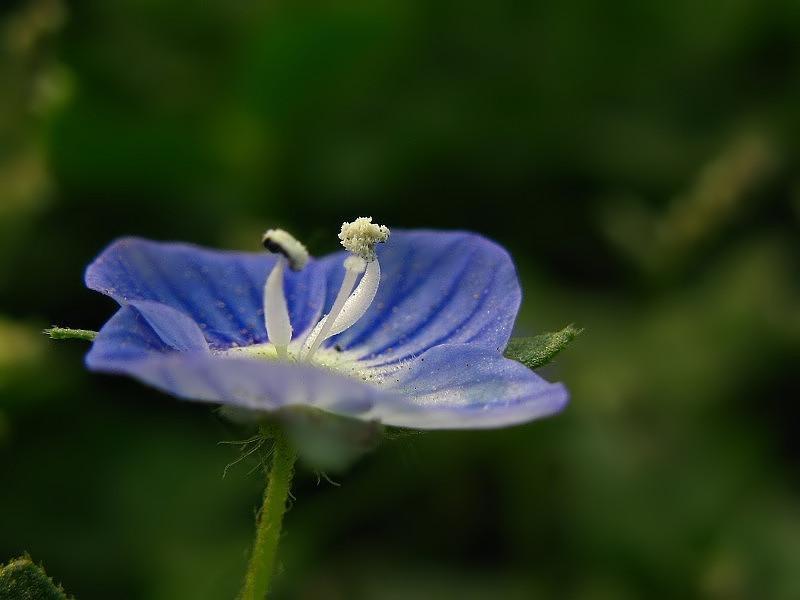
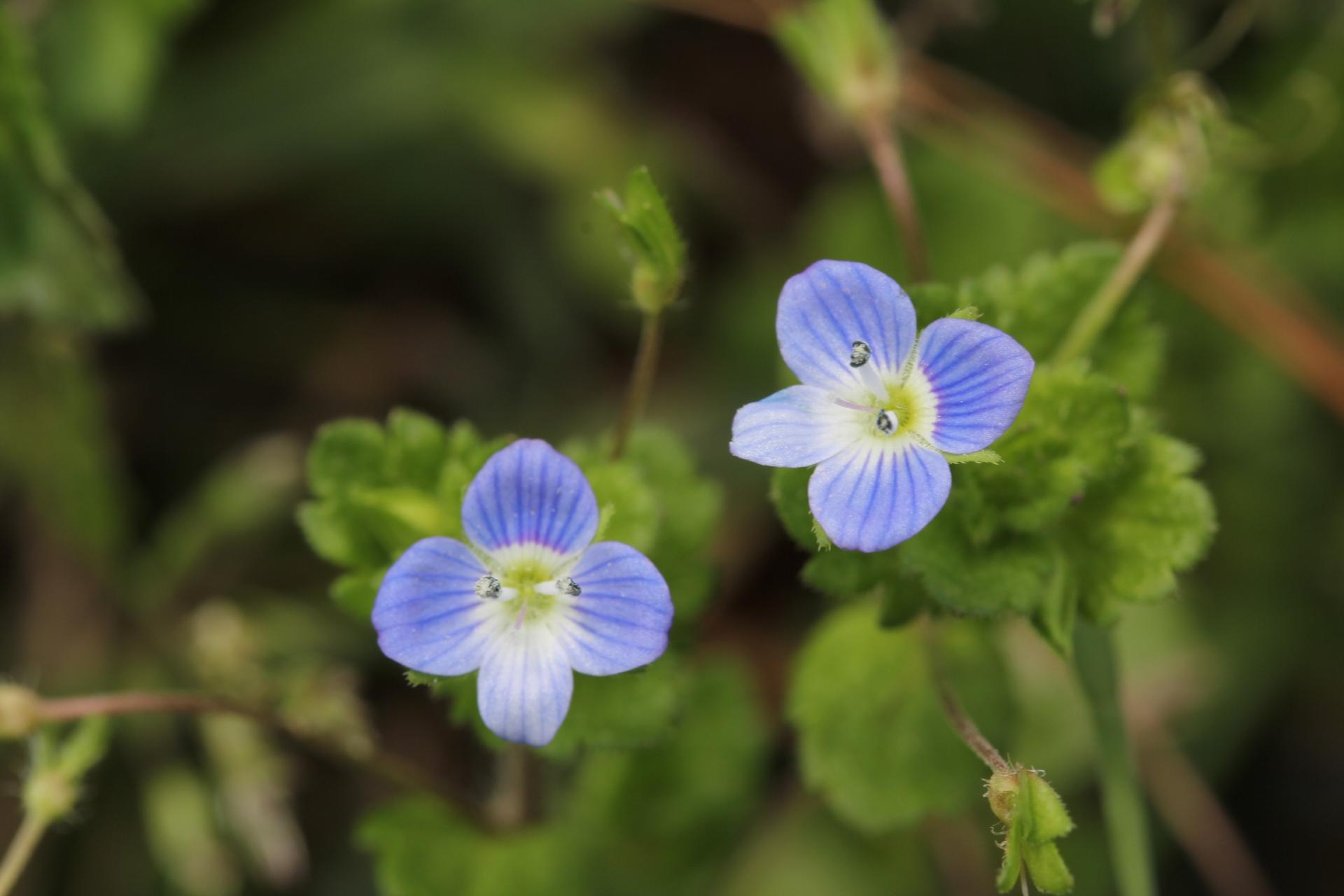
Persian Veronica, Latin name Veronica, persica, Poir.
Arabia is a cashier, mother-in-law
Scrophulariaceae veronical
Geographical distribution of Veronica, Arabia
Native to Western Asia to Iran and europe. At present, China is mainly distributed in East China, central China and Western china.
Morphological characteristics of Veronica in Arabia
Veronica in Arabia is a branched herb with a villous surface. Stems branched from base, lower part on ground, leaf blade opposite at base of stem, upper leaves alternate. Leaves 2-4 pairs, ovate or round, petiole shorter, leaf base shallowly cordate, blade margin obtuse, upper and lower two surfaces sparsely villous. Arabia Veronica flower alone in the axil, the Corolla is light blue, petals on the radiation of dark blue stripes; bracts alternate, with leaves of the same shape, and similar size. Capsule is kidney shape, the surface by glandular hairs, mature almost hairless, reticulate veins are obvious, the lobes are blunt. There is a deep horizontal line on the back of the seed, the florescence is in 3-5 months.
Gardening value of Veronica, Arabia
Arabia speedwell two vigorous growth period at the end of November and the month of 3~4. Because Veronica, Arabia, has a strong asexual capacity, she can plant Veronica on a bare surface that can quickly cover the surface.
The main dangers of Veronica in Arabia
Arabia speedwell as invasive species, with no natural predators, breed very quickly, will harm the summer crops and autumn crop seedlings, a variety of parasitic pathogens on roots in the plant and spread to other crops.
The breeding of Veronica in Arabia
Arabia Veronica can not only sexually reproduce, but also through asexual reproduction to maintain population reproduction, asexual reproduction can effectively reduce the risk of sexual reproduction. In the case of annuals, asexual reproduction ultimately results in the number of individual plants in the next growing season by sexual reproduction.
Under different densities, the asexual reproduction of Veronica officinalis in Arabia has different effects on sexual reproduction. No significant difference even in quantity, the nutrition component of the length and weight of the case, the resource allocation proportion of the number of fruit and fruit, erect on the significant or extremely significant difference. This shows that the density distribution has a certain impact conditions in parts of Arabia on sexual reproduction of Veronica and resources, in the case of high density, Arabia speedwell in order to adapt to the stronger competition pressure, may be in the process of growth of nutrition component, has no obvious effect on the reproduction and in the low; under the condition of density, intraspecific and interspecific competition pressure is smaller, thus changing all the nutritional components will significantly affect the change of dry weight and the number of Arabia mother-in-law individualplant nano fruit. Therefore, in the low density, intraspecific and interspecific competition is weak, all Arabia speedwell during vegetative growth on the sexual reproduction have obvious effect, but with the increase of the density, impact on the growth of vegetative organs of some reproductive organs will gradually weaken. In addition to the biological characteristics of Veronica in Arabia, environmental conditions may also have some effects on their vegetative growth and sexual reproduction.



0
0
文章
Dummer. ゛☀
2017年06月30日

Also known as field poppies (field poppy) or Flanders poppy.
The scientific name is Papaver rhoeas.
Poppy, (Papaveraceae) (Abraham biennial) annual plant, native to Europe, North Africa and Asia, has been introduced to Australia, New Zealand and North america.
Peanut in 25W64; 90 cm (10W64; 35 inches) tall on stem top, ca. 7W64 in diam., 10 cm. Petals 4, usually bright red, sometimes with a black spot at the base.
Once widely cultivated poppy weed distribution in seed dormancy years in soil, in the soil by plowing when germination.
During the first World War and after the war, war-torn land opening times of poppy, poppy and become a symbol of the war.
Poppy Shirley (Shirley poppy) is one of the most commonly cultivated species of garden poppy, poppy bred by.
Poppy can be a red dye used as extraction agent of some Tim color wine and drugs.
In fact, a poppy is poppy, because all plant Ranunculus orders, poppy, poppy, are called poppy.
However, most poppies are planted, but the poppy, poppy, opium poppy, poppy, and poppy seeds of the genus Papaver can be used for the manufacture of narcotic drugs, and the State prohibits the cultivation.
Europe, sub continent temperate zone, the world each place has the cultivation, Belgium regards it as the national flower.
Now in China poppy widely cultivated in Jiangsu and Zhejiang provinces most. Is the fine spring flower beds, flower border and beautify the courtyard, also but potted or cut.

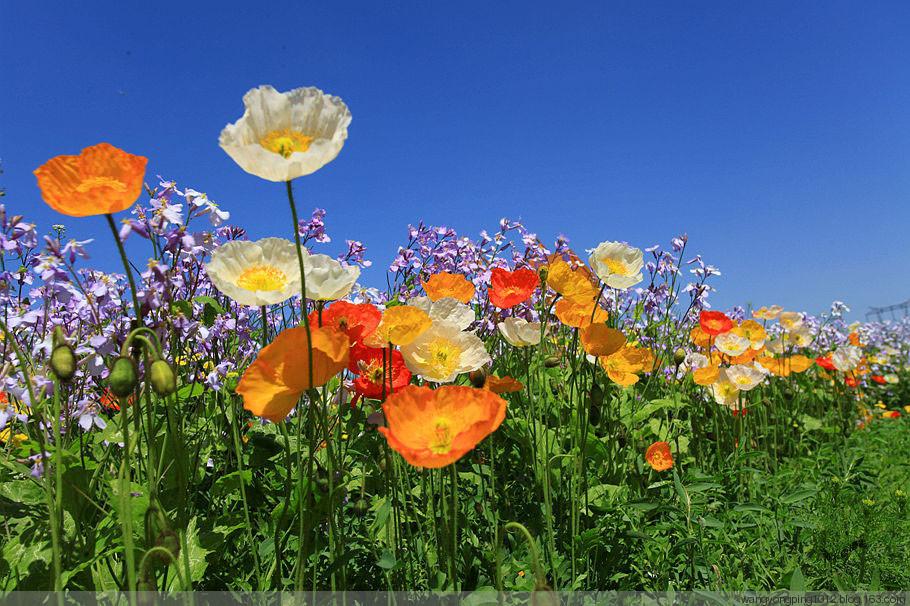

The scientific name is Papaver rhoeas.
Poppy, (Papaveraceae) (Abraham biennial) annual plant, native to Europe, North Africa and Asia, has been introduced to Australia, New Zealand and North america.
Peanut in 25W64; 90 cm (10W64; 35 inches) tall on stem top, ca. 7W64 in diam., 10 cm. Petals 4, usually bright red, sometimes with a black spot at the base.
Once widely cultivated poppy weed distribution in seed dormancy years in soil, in the soil by plowing when germination.
During the first World War and after the war, war-torn land opening times of poppy, poppy and become a symbol of the war.
Poppy Shirley (Shirley poppy) is one of the most commonly cultivated species of garden poppy, poppy bred by.
Poppy can be a red dye used as extraction agent of some Tim color wine and drugs.
In fact, a poppy is poppy, because all plant Ranunculus orders, poppy, poppy, are called poppy.
However, most poppies are planted, but the poppy, poppy, opium poppy, poppy, and poppy seeds of the genus Papaver can be used for the manufacture of narcotic drugs, and the State prohibits the cultivation.
Europe, sub continent temperate zone, the world each place has the cultivation, Belgium regards it as the national flower.
Now in China poppy widely cultivated in Jiangsu and Zhejiang provinces most. Is the fine spring flower beds, flower border and beautify the courtyard, also but potted or cut.



0
0
文章
Eyin Thor
2017年05月23日

Growing eggplants in containers is not complicated, and if you’re a fan of grilling and oven broiling, you should grow this delicious and PRODUCTIVE vegetable.
Eggplant is a perennial tropical vegetable plant native to South and East Asia (namely, China and India) and a member of the tomato family. The plant loves heat and full sun and requires evenly moist soil in its native environment to thrive and fruit heavily.
These are the medium sized bushes, and nowadays a much more dwarf and compact cultivars are available for limited space gardeners. Similar to the other cousins of nightshade family e.g. tomatoes and peppers, it is possible to grow this vegetable in a container.
How to Grow Eggplants in Pots
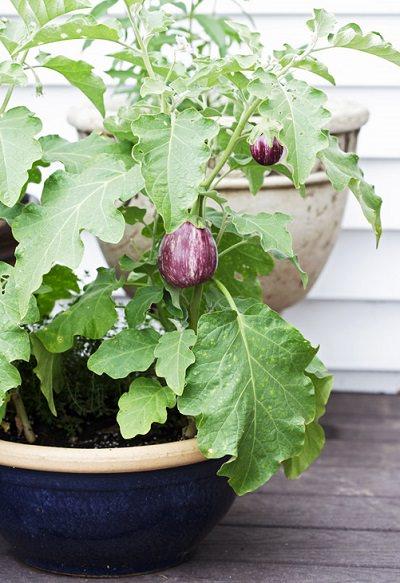
Growing eggplants in pots is possible in two ways– Either start them using seeds or buy the seedlings from a nearby nursery or garden center. If you’re new to growing plants and have not grown them much– buy a few seedlings of your favorite eggplant variety. This will make things hassle free! If you’ve decided to germinate them from seeds, then that is also relatively easy.
Planting Time
Usually, in the spring, it’s the season when eggplant seedlings are transplanted on the ground when all the dangers of frost are passed. BUT container grown eggplants can be planted in summer and even in early fall, if you’re ready to move the pots here and there to control the temperature, especially during the nighttime when the temperature dips down. If you’re growing eggplants in a hot and warm frost-free climate, planting in winter is also possible.
Note that; this vegetable plant is more sensitive to low temperatures than tomatoes and peppers.Starting Eggplants from Seeds
Ensure you plant up to two seeds in each cell of a seedling tray or directly sow two seeds in each container. Remember, the eggplants require a lot of warmth for germination, more than tomatoes and peppers. Therefore, if you think the outdoors is not warm enough (temperature above 68 F (20 C) is good enough for eggplant seeds to germinate), you can place them indoors to kick start their growth, that’s the best of container gardening. Once they have sprouted and had up to four leaves, they can be transplanted into the desired containers.
Choosing a Pot
You’ll need a large container, depending on the cultivar, the larger the variety you’re growing, the larger the pot! Usually, the eggplant is relatively large, similar to a pepper plant or tomato so it requires a large pot which should be big enough for the capacity of five gallons, at least. In other words, use a pot that is at least 12 inches deep in size for each plant. If growing in a cooler region, choose a pot that retains heat. Here’s an informative article on choosing the best pot type for your container garden!
Requirements for Growing Eggplants in Containers
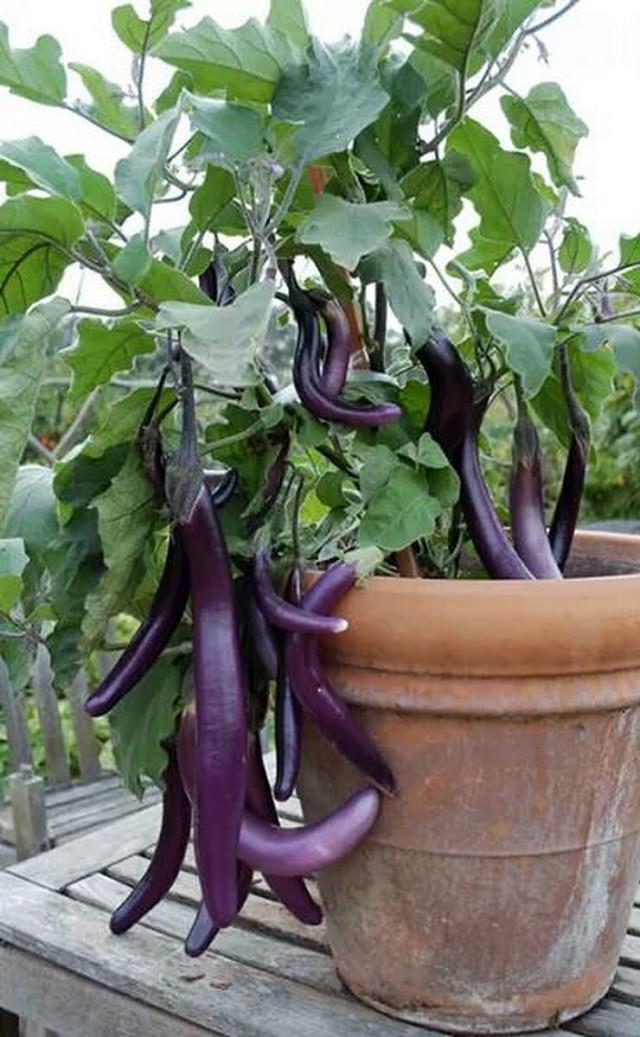
Position
Place the pots in a spot which has good air circulation and gets direct sunlight and some wind. This is because the eggplant requires a lot of warmth and sun exposure when growing. West or south facing direction is appropriate.
Soil
The eggplants require a lot of nutrients for growth and a neutral or slightly acidic soil in pH. Use soil that is rich in nutrients, most preferably loamy soilless potting mix. Eggplants thrive in the soil which has adequate and sufficient moisture so think about the moisture retaining capability of soil too. Therefore, you should also add a lot of compost or aged manure to the soil to enhance its capacity to retain water.
Watering
Eggplants love to grow in evenly moist soil, ensure you provide adequate moisture for them. Make sure the drainage is good to avoid root rot. Also, take care not to saturate the soil with too much water making it soggy.
Fertilizer
To provide ample nutrients for more productivity, you should apply fertilizer following the recommendations on the fertilizer bag. As eggplants are heavy feeders and need the fertilizer high in phosphorous, use the 5-10-5 fertilizer or other in a similar ratio, you can apply the balanced fertilizer, too. If required, spray on the leaves of your plants with liquid plant food, typically known as the foliar feeding.
Temperature
Once the plants are germinated and transplanted into the pots, provide them heat and try to keep them in the temperature above 50-54 F (10-12 C). If you’re growing eggplants in a warm climate, you don’t need to worry about temperature requirements much.
Eggplant Care
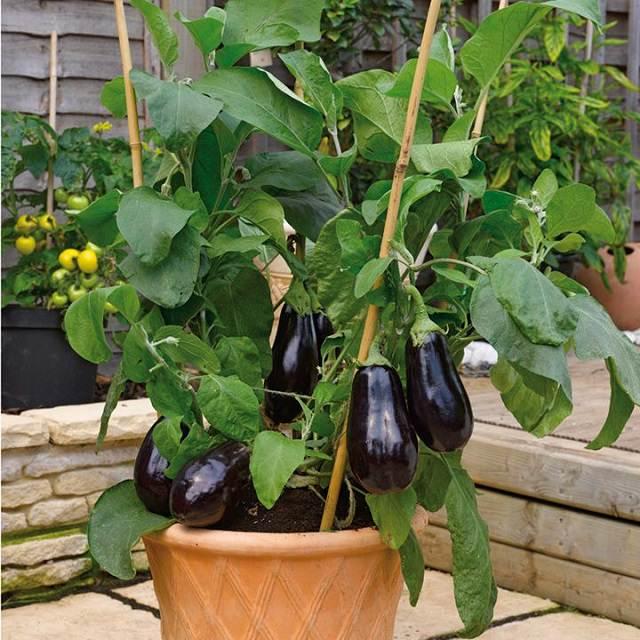
Pruning and Removing Suckers
Growing eggplant in a pot is not different than tomatoes, however, pruning it and picking the suckers is not necessary unlike TOMATOES but to improve productivity you can do this. When the plants are mature, you’ll need to look out for suckers to remove them. Yellowing or diseased leaves or branches growing tall and lanky and hindering the growth and productivity should be removed too.
Staking
As eggplant bush grows tall and its fruits are plump and heavy, you’ll need to tie your plants to the stake to support them. The most simple thing you can do is to thrust a stick in the pot and tie your plant to it, you can also use a cage to help the plant from falling.
Pests and Diseases
The most common pests for the eggplant is the black flea beetle, which feeds on the leaves of the plant, these insects are the common sight but if the plant is healthy, they won’t do any harm and also the aphids. One more common pest is the cutworm. This worm, as its name suggests, usually cuts the plant at its base. This can be prevented by using a cutworm collar or you can easily eliminate them by yourself. These pests can also be controlled using CHEMICAL pesticides, which we don’t recommend.
Eggplants grown in pots don’t get affected by diseases often. However, if you want, check out the list of eggplant diseases here!
Harvesting
The eggplant usually reaches maturity after two to three months after planting, to say more clearly, in 60-80 days, depending more the type of variety you’re growing and the climate. At around this time, the plant starts to produce fruits which grow to become glossy when fully mature.
Eggplant is a perennial tropical vegetable plant native to South and East Asia (namely, China and India) and a member of the tomato family. The plant loves heat and full sun and requires evenly moist soil in its native environment to thrive and fruit heavily.
These are the medium sized bushes, and nowadays a much more dwarf and compact cultivars are available for limited space gardeners. Similar to the other cousins of nightshade family e.g. tomatoes and peppers, it is possible to grow this vegetable in a container.
How to Grow Eggplants in Pots

Growing eggplants in pots is possible in two ways– Either start them using seeds or buy the seedlings from a nearby nursery or garden center. If you’re new to growing plants and have not grown them much– buy a few seedlings of your favorite eggplant variety. This will make things hassle free! If you’ve decided to germinate them from seeds, then that is also relatively easy.
Planting Time
Usually, in the spring, it’s the season when eggplant seedlings are transplanted on the ground when all the dangers of frost are passed. BUT container grown eggplants can be planted in summer and even in early fall, if you’re ready to move the pots here and there to control the temperature, especially during the nighttime when the temperature dips down. If you’re growing eggplants in a hot and warm frost-free climate, planting in winter is also possible.
Note that; this vegetable plant is more sensitive to low temperatures than tomatoes and peppers.Starting Eggplants from Seeds
Ensure you plant up to two seeds in each cell of a seedling tray or directly sow two seeds in each container. Remember, the eggplants require a lot of warmth for germination, more than tomatoes and peppers. Therefore, if you think the outdoors is not warm enough (temperature above 68 F (20 C) is good enough for eggplant seeds to germinate), you can place them indoors to kick start their growth, that’s the best of container gardening. Once they have sprouted and had up to four leaves, they can be transplanted into the desired containers.
Choosing a Pot
You’ll need a large container, depending on the cultivar, the larger the variety you’re growing, the larger the pot! Usually, the eggplant is relatively large, similar to a pepper plant or tomato so it requires a large pot which should be big enough for the capacity of five gallons, at least. In other words, use a pot that is at least 12 inches deep in size for each plant. If growing in a cooler region, choose a pot that retains heat. Here’s an informative article on choosing the best pot type for your container garden!
Requirements for Growing Eggplants in Containers

Position
Place the pots in a spot which has good air circulation and gets direct sunlight and some wind. This is because the eggplant requires a lot of warmth and sun exposure when growing. West or south facing direction is appropriate.
Soil
The eggplants require a lot of nutrients for growth and a neutral or slightly acidic soil in pH. Use soil that is rich in nutrients, most preferably loamy soilless potting mix. Eggplants thrive in the soil which has adequate and sufficient moisture so think about the moisture retaining capability of soil too. Therefore, you should also add a lot of compost or aged manure to the soil to enhance its capacity to retain water.
Watering
Eggplants love to grow in evenly moist soil, ensure you provide adequate moisture for them. Make sure the drainage is good to avoid root rot. Also, take care not to saturate the soil with too much water making it soggy.
Fertilizer
To provide ample nutrients for more productivity, you should apply fertilizer following the recommendations on the fertilizer bag. As eggplants are heavy feeders and need the fertilizer high in phosphorous, use the 5-10-5 fertilizer or other in a similar ratio, you can apply the balanced fertilizer, too. If required, spray on the leaves of your plants with liquid plant food, typically known as the foliar feeding.
Temperature
Once the plants are germinated and transplanted into the pots, provide them heat and try to keep them in the temperature above 50-54 F (10-12 C). If you’re growing eggplants in a warm climate, you don’t need to worry about temperature requirements much.
Eggplant Care

Pruning and Removing Suckers
Growing eggplant in a pot is not different than tomatoes, however, pruning it and picking the suckers is not necessary unlike TOMATOES but to improve productivity you can do this. When the plants are mature, you’ll need to look out for suckers to remove them. Yellowing or diseased leaves or branches growing tall and lanky and hindering the growth and productivity should be removed too.
Staking
As eggplant bush grows tall and its fruits are plump and heavy, you’ll need to tie your plants to the stake to support them. The most simple thing you can do is to thrust a stick in the pot and tie your plant to it, you can also use a cage to help the plant from falling.
Pests and Diseases
The most common pests for the eggplant is the black flea beetle, which feeds on the leaves of the plant, these insects are the common sight but if the plant is healthy, they won’t do any harm and also the aphids. One more common pest is the cutworm. This worm, as its name suggests, usually cuts the plant at its base. This can be prevented by using a cutworm collar or you can easily eliminate them by yourself. These pests can also be controlled using CHEMICAL pesticides, which we don’t recommend.
Eggplants grown in pots don’t get affected by diseases often. However, if you want, check out the list of eggplant diseases here!
Harvesting
The eggplant usually reaches maturity after two to three months after planting, to say more clearly, in 60-80 days, depending more the type of variety you’re growing and the climate. At around this time, the plant starts to produce fruits which grow to become glossy when fully mature.
0
0
文章
Micky
2017年05月22日

Learn how to plant thuja, it’s one of the fast growing privacy trees you’d like to plant in your garden.
Thuja is a small genus belonging to the group of conifers and to the family of Cupressaceae. It is native to North America and Asia. It has a columnar habit and flattened branches. Some of its varieties can reach up to 200 feet tall in favorable climate.
USDA Zones — 3 – 11
Propagation Method — Seeds, vegetative propagation
Difficulty — Easy
Soil pH — 6 – 8
Varieties and How to Plant Thuja
There are three species most widespread: Thuja green giant, which is a hybrid of thuja plicata and Thuja standishii– the most popular cultivar that reaches height of 18 to 25 m and has very rapid growth and ornamental use. The tops of its branches are solid to the touch and its foliage are mildly fragrant.
Thuja occidentalis, also called as white cedar is famous for its amazing ornamental foliage. It’s a beautiful small tree that gives rustic appearance. It grows between to 10 to 20 meters high.
Thuja plicata is also referred as giant or western arborvitae. It grows up to amazing height of 55 to 60 m (180 to 200 ft).
Propagation
It can be propagated from seeds, cuttings and air layering. Propagate in summer using fresh cuttings.
Position for Growing Arborvitae
Thuja grows easily in both full sun and partial shade. However, exposure to cold harsh winds can be damaging to young plants.
RequirementsSoil
Thuja grows in most soil types. But the best soil for it is fertile soil that has ability to retain moisture. It also tolerates very chalky soils.
Watering
Water thuja deeply. Soil around it should be kept moist and covered, constantly, from a mulch of organic material.
Fertilizer
It needs regular fertilization to grow fast. Feed it with balanced liquid fertilizer in the beginning of growing season to kick start the growth.
Thuja CarePruning
It doesn’t require pruning as it naturally grows in columnar shape. Although if you are growing this for hedge prune regularly to maintain shape. It can tolerate excessive pruning without any problem.
Pests and Diseases
Thuja is a small genus belonging to the group of conifers and to the family of Cupressaceae. It is native to North America and Asia. It has a columnar habit and flattened branches. Some of its varieties can reach up to 200 feet tall in favorable climate.

USDA Zones — 3 – 11
Propagation Method — Seeds, vegetative propagation
Difficulty — Easy
Soil pH — 6 – 8
Varieties and How to Plant Thuja
There are three species most widespread: Thuja green giant, which is a hybrid of thuja plicata and Thuja standishii– the most popular cultivar that reaches height of 18 to 25 m and has very rapid growth and ornamental use. The tops of its branches are solid to the touch and its foliage are mildly fragrant.
Thuja occidentalis, also called as white cedar is famous for its amazing ornamental foliage. It’s a beautiful small tree that gives rustic appearance. It grows between to 10 to 20 meters high.
Thuja plicata is also referred as giant or western arborvitae. It grows up to amazing height of 55 to 60 m (180 to 200 ft).
Propagation
It can be propagated from seeds, cuttings and air layering. Propagate in summer using fresh cuttings.
Position for Growing Arborvitae
Thuja grows easily in both full sun and partial shade. However, exposure to cold harsh winds can be damaging to young plants.
RequirementsSoil
Thuja grows in most soil types. But the best soil for it is fertile soil that has ability to retain moisture. It also tolerates very chalky soils.
Watering
Water thuja deeply. Soil around it should be kept moist and covered, constantly, from a mulch of organic material.
Fertilizer
It needs regular fertilization to grow fast. Feed it with balanced liquid fertilizer in the beginning of growing season to kick start the growth.
Thuja CarePruning
It doesn’t require pruning as it naturally grows in columnar shape. Although if you are growing this for hedge prune regularly to maintain shape. It can tolerate excessive pruning without any problem.
Pests and Diseases
1
0
文章
Abigal
2017年03月14日


An essential ingredient in Thai and Cambodian recipes, krachai or Chinese ginger is one of the rare & exotic herbs grown in Southeast Asia.
Its rhizomes are used as a spice, exude mild ginger and citrus like flavor.
Unavailable fresh in most parts of the world, so why not plant it in your backyard? Learn how to grow it and enjoy it fresh.
Growing and Planting
Growing it is similar to ginger plant. If you’re growing it in a container, you can plant it any time, unless spring is the best growing season. It’s a slow grower and reaches up to the height of 2-4 feet. The plant looks vaguely like iris and blooms beautiful pale pink flowers. It looks wonderful in balcony or patio.
Plant rhizomes 5 cm deep with the eyes facing up in good potting soil, keep it in partial shade in less windy spot. It prefers slightly moist soil of pH level 6 to 8 and humid surroundings.

Preferable climate
USDA Zone 8-12, it is easy to grow in subtropical and tropical region, but if you’re living in colder part below Zone 9 place it in a sunny spot and keep it indoors in winter.
Harvesting & Uses
Dig out the rhizomes when plant start to wilt and leaves become yellow or harvest its leaves to make tea. Both leaves and rhizomes are edible. It’s grown for medicinal uses in China and India and for culinary uses in East Asia. It can be eaten raw in salads, with fishes, made into pickles, can be used in seafood. You can also use it in soups and curries.
1
1
成长记
Plants Encyclopdias
2016年08月17日

Name: Fortune's spindle Blondy
Latin: Euonymus fortunei
Origin: Asia
Plant height: 30 - 60 cm
Reproduction: #Seeds
Difficulty level: #Medium
Tags: #Asia #Euonymusfortunei

Latin: Euonymus fortunei
Origin: Asia
Plant height: 30 - 60 cm
Reproduction: #Seeds
Difficulty level: #Medium
Tags: #Asia #Euonymusfortunei

7
2
成长记
Plants Encyclopdias
2016年08月17日

Name: Fortune's spindle
Latin: Euonymus fortunei
Origin: Asia
Plant height: 30 - 60 cm
Reproduction: #Seeds
Difficulty level: #Medium
Tags: #Asia #Euonymusfortunei
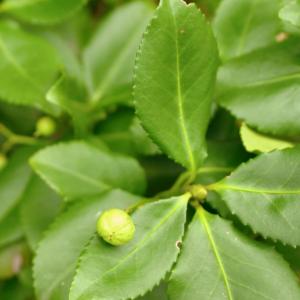
Latin: Euonymus fortunei
Origin: Asia
Plant height: 30 - 60 cm
Reproduction: #Seeds
Difficulty level: #Medium
Tags: #Asia #Euonymusfortunei

3
2
成长记
Plants Encyclopdias
2016年08月17日

Name: Winged spindle
Latin: Euonymus alatus
Origin: Asia
Plant height: 80 - 150 cm
Reproduction: #Seeds
Difficulty level: #Medium
Tags: #Asia #Euonymusalatus

Latin: Euonymus alatus
Origin: Asia
Plant height: 80 - 150 cm
Reproduction: #Seeds
Difficulty level: #Medium
Tags: #Asia #Euonymusalatus

7
2


